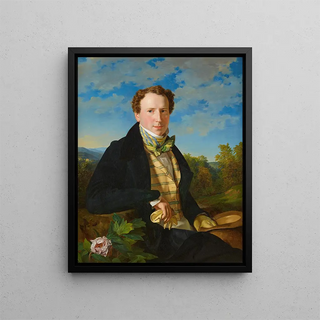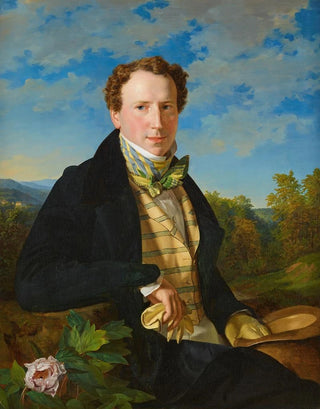Art print | Self-portrait at a young age - Ferdinand Georg Waldmüller Source: Reproduction | Autoportrait à un jeune âge - Ferdinand Georg Waldmüller


View from behind

Frame (optional)
Autoportrait at a young age - Ferdinand Georg Waldmüller – Captivating introduction
In the fascinating world of art, every artwork tells a unique story, a reflection of its creator's soul. The Autoportrait at a young age by Ferdinand Georg Waldmüller is no exception. This painting, imbued with deep introspection, immerses us in the thoughts of an artist at a crossroads, oscillating between youth and maturity. Through this masterpiece, Waldmüller invites us to explore not only his own artistic journey but also the values and emotions that shaped his era. The light and shadows, the choice of colors, as well as the expression on the young artist's face, form a composition that provokes and captivates, revealing a rare psychological depth.
Style and uniqueness of the work
The Autoportrait at a young age stands out for its characteristic style, which combines realism and romanticism. Waldmüller, master of light and nuances, manages to create an intimate atmosphere where every detail matters. The gaze of the young man, both thoughtful and determined, seems to pierce the viewer, establishing a unique connection. The warm colors, carefully chosen, evoke a delicate sensitivity, while the texture of the paint reveals the artist's technical mastery. Every brushstroke reflects a search for truth and authenticity, placing this painting at the heart of 19th-century aesthetics. Through this portrait, Waldmüller does not merely depict his image; he offers a reflection on identity, youth, and the passage of time—universal themes that still resonate today.
The artist and his influence
Ferdinand Georg Waldmüller, born in 1793 in Vienna, is an emblematic figure of the Austrian artistic movement. His work, marked by romantic sensitivity, profoundly influenced his contemporaries and future generations. Waldmüller stands out for his ability to capture the human essence in his portraits, combining rigorous technique with an intuitive understanding of emotions. He established himself as a pioneer of realism, anticipating the artistic currents that would emerge later in Europe. His contribution is not limited to

Matte finish

View from behind

Frame (optional)
Autoportrait at a young age - Ferdinand Georg Waldmüller – Captivating introduction
In the fascinating world of art, every artwork tells a unique story, a reflection of its creator's soul. The Autoportrait at a young age by Ferdinand Georg Waldmüller is no exception. This painting, imbued with deep introspection, immerses us in the thoughts of an artist at a crossroads, oscillating between youth and maturity. Through this masterpiece, Waldmüller invites us to explore not only his own artistic journey but also the values and emotions that shaped his era. The light and shadows, the choice of colors, as well as the expression on the young artist's face, form a composition that provokes and captivates, revealing a rare psychological depth.
Style and uniqueness of the work
The Autoportrait at a young age stands out for its characteristic style, which combines realism and romanticism. Waldmüller, master of light and nuances, manages to create an intimate atmosphere where every detail matters. The gaze of the young man, both thoughtful and determined, seems to pierce the viewer, establishing a unique connection. The warm colors, carefully chosen, evoke a delicate sensitivity, while the texture of the paint reveals the artist's technical mastery. Every brushstroke reflects a search for truth and authenticity, placing this painting at the heart of 19th-century aesthetics. Through this portrait, Waldmüller does not merely depict his image; he offers a reflection on identity, youth, and the passage of time—universal themes that still resonate today.
The artist and his influence
Ferdinand Georg Waldmüller, born in 1793 in Vienna, is an emblematic figure of the Austrian artistic movement. His work, marked by romantic sensitivity, profoundly influenced his contemporaries and future generations. Waldmüller stands out for his ability to capture the human essence in his portraits, combining rigorous technique with an intuitive understanding of emotions. He established himself as a pioneer of realism, anticipating the artistic currents that would emerge later in Europe. His contribution is not limited to






